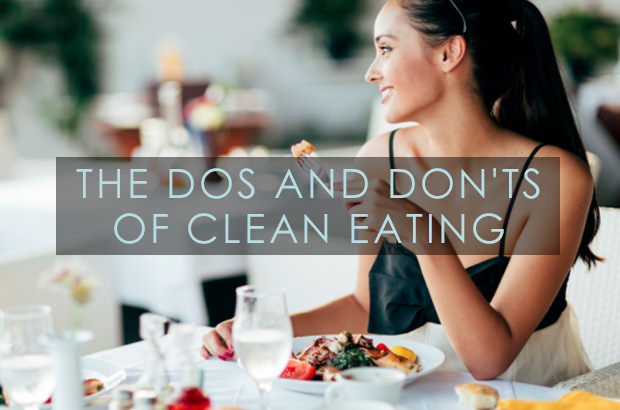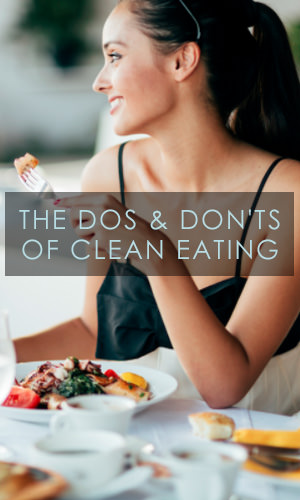
The DOs And DON'Ts Of Clean Eating

Posted on 09 Oct, 2022

You've probably heard of "clean eating" before but aren't exactly sure what it entails or how to even get started. Eating clean means keeping food simple. It means focusing on choosing nutrient-dense foods in their natural state (or close to it), rather than eating highly processed foods with added chemicals and preservatives. Follow these 11 simple steps to get started on cleaning up your diet.
1. Become an Avid Label Reader
 DO: Get in the habit of reading nutrition labels thoroughly. Even products generally perceived as healthy may contain unnecessary ingredients. Whilst the idea of reading every single label might sound tedious, it’s absolutely necessary. You will find common brands of tea that puts modified cornstarch in their tea bags, and lime-and-salt microwave popcorn that’s less healthy than what you’d get in the movie theater.
DO: Get in the habit of reading nutrition labels thoroughly. Even products generally perceived as healthy may contain unnecessary ingredients. Whilst the idea of reading every single label might sound tedious, it’s absolutely necessary. You will find common brands of tea that puts modified cornstarch in their tea bags, and lime-and-salt microwave popcorn that’s less healthy than what you’d get in the movie theater.
DON’T: Buy anything with a long laundry list of ingredients you can’t pronounce — the shorter the list of ingredients, the better. Try to derive most of your diet from foods that don’t require labels.
[Related: Common Food Labelling Tricks]
2. Re-Evaluate Your “Process”
 DO: Cut down on highly-processed foods. This is one of the first steps to eating clean. It’s important to reduce, not necessarily eliminate, your intake of processed foods that are loaded with chemicals, preservatives and dyes, as well as foods high in sugar and poor-quality oils.
DO: Cut down on highly-processed foods. This is one of the first steps to eating clean. It’s important to reduce, not necessarily eliminate, your intake of processed foods that are loaded with chemicals, preservatives and dyes, as well as foods high in sugar and poor-quality oils.
DON’T: Discount all processed foods. For instance, some foods, like bagged spinach and pre-cut vegetables are minimally processed simply for convenience, and other foods are processed to enhance nutritional value, such as added-fiber breakfast cereal and milk that’s fortified with calcium and vitamin D. Reading the nutrition label should provide a good overview of how heavily processed the product actually is.
[Related: 38 Things You Can Freeze To Save Time And Money]
3. Plant the Seed for Cleaner Eating
 DO: Gravitate toward a plant-based diet. This doesn’t mean you need to be vegetarian or vegan, but it does mean you should eat lots of vegetables, along with fruit, nuts, seeds, herbs and spices, to ensure you are getting lots of nutrients. For an easy guideline, the U.S. Department of Agriculture recommends filling at least half of your plate with fruits and vegetables at every meal.
DO: Gravitate toward a plant-based diet. This doesn’t mean you need to be vegetarian or vegan, but it does mean you should eat lots of vegetables, along with fruit, nuts, seeds, herbs and spices, to ensure you are getting lots of nutrients. For an easy guideline, the U.S. Department of Agriculture recommends filling at least half of your plate with fruits and vegetables at every meal.
DON’T: Forget to incorporate lots of proteins if you’re forgoing meat. Plant-based foods especially high in protein include chia seeds, hemp seeds, lentils and adzuki, cannellini and kidney beans.
[Related: 29 Recipes That Prove Clean Eating Can Be Easy and Delicious]
4. Go Whole Grain
 DO: Choose sprouted or whole grains over processed grains. Harvard researchers actually recommend devoting a quarter of your plate at any meal to whole grains, thanks to studies that show reduced risk of cardiovascular disease, Type 2 diabetes and colorectal cancer. Ways to up your whole-grain intake include eating quinoa, brown rice and whole-grain pilaf.
DO: Choose sprouted or whole grains over processed grains. Harvard researchers actually recommend devoting a quarter of your plate at any meal to whole grains, thanks to studies that show reduced risk of cardiovascular disease, Type 2 diabetes and colorectal cancer. Ways to up your whole-grain intake include eating quinoa, brown rice and whole-grain pilaf.
DON’T: Be fooled by confusing packaging. Buzzwords like “multigrain,” “100-percent wheat” and “stone ground” do not necessarily denote whole-grain foods. Also, look for these five USDA guidelines: whole grain as the first ingredient, no added sugars in the first three ingredients, the word “whole” before any grain ingredient, a carbohydrate-to-fiber ratio of less than 10:1 and a stamp reading “whole grain.”
[Related: How to Pick the Healthiest Bread]
5. Get to the Meat of the Matter
 Though many envision a vegetarian diet in association with clean eating, meat can certainly be part of the equation if enjoyed responsibly.
Though many envision a vegetarian diet in association with clean eating, meat can certainly be part of the equation if enjoyed responsibly.
DO: “Choose higher-quality meats, ideally pasture-raised and grass-fed, or at the very least free of hormones and antibiotics. Case in point: A study published in the Nutrition Journal in 2010 found that grass-fed beef had less cholesterol-elevating saturated fatty acids and was higher in precursors for vitamin A, vitamin E and cancer-fighting antioxidants and omega-3 fatty acids than grain-fed beef.
DON’T: Overdo it and avoid highly-processed meats (think bacon and sausage).
[Related: Meat Labels And What They Mean]
6. Satisfy Your Sweet Tooth the Natural Way
 DO: If you're going to add sugar to your diet, do it by way of natural sugars -- honey, agave, etc. Most of us however are overdoing it when it comes to added sugars and could benefit from cutting back altogether. The 2015 Dietary Guidelines recommend that limit added to sugar to less than 10 percent of your total daily calories.
DO: If you're going to add sugar to your diet, do it by way of natural sugars -- honey, agave, etc. Most of us however are overdoing it when it comes to added sugars and could benefit from cutting back altogether. The 2015 Dietary Guidelines recommend that limit added to sugar to less than 10 percent of your total daily calories.
DON’T: Consume artificial sweeteners, such as sucralose or aspartame. A 2014 study published in Nature found that consumption of such non-caloric artificial sweeteners could cause abnormal metabolism and a higher risk of diabetes. Choose natural alternatives like honey, molasses, agave nectar and maple syrup.
[Related: The 12 Best And Worst Sugar Substitutes]
7. Shop Smart
 DO: Maximize your fresh-food shopping efforts by checking dates before buying and reaching for the freshest fare at the grocery store. So many people don’t buy healthy food because they claim it goes bad more quickly. It does spoil more quickly than processed foods, but if you look at dates and buy the products all the way in the back of the refrigerator, your food will last much longer.
DO: Maximize your fresh-food shopping efforts by checking dates before buying and reaching for the freshest fare at the grocery store. So many people don’t buy healthy food because they claim it goes bad more quickly. It does spoil more quickly than processed foods, but if you look at dates and buy the products all the way in the back of the refrigerator, your food will last much longer.
DON’T: Throw food away without knowing the difference between the “sell by” and “use by” labeling. A 2013 report from the National Resource Defense Council found that 91 percent of consumers mistakenly threw food away based on the “sell by” date, even though the food was still safe to eat.
[Related: 9 Easy Overnight Vegetarian Breakfasts]
8. Create a Balanced Plate
 DO: Make sure to eat a mix of lean proteins, healthy fats and complex carbohydrates at mealtime. Examples of complex carbohydrates include legumes, starchy vegetables and whole-grain cereals, while lean proteins include lean meats, egg whites, beans, legumes and poultry. To get your dose of healthy fats, choose nuts, avocados and olive oil.
DO: Make sure to eat a mix of lean proteins, healthy fats and complex carbohydrates at mealtime. Examples of complex carbohydrates include legumes, starchy vegetables and whole-grain cereals, while lean proteins include lean meats, egg whites, beans, legumes and poultry. To get your dose of healthy fats, choose nuts, avocados and olive oil.
DON’T: When sitting down to dinner, don’t eat bread and a starch and have a glass of wine and a dessert. One of these, rather than all four, along with plenty of lean protein and vegetables, would create a balanced meal.
[Related: How To Stretch Your Carbohydrate Intake]
9. Stay Hydrated
 DO: Drink plenty of water throughout your daily routine. Experts recommend drinking six to eight 8-ounce glasses, or about two liters, every day. The amount you need varies from person to person, depending on activity level and climate. If you’re not a big fan of H2O, you can up your intake of foods that are 85 to 95 percent water, such as celery, tomatoes, oranges and melons.
DO: Drink plenty of water throughout your daily routine. Experts recommend drinking six to eight 8-ounce glasses, or about two liters, every day. The amount you need varies from person to person, depending on activity level and climate. If you’re not a big fan of H2O, you can up your intake of foods that are 85 to 95 percent water, such as celery, tomatoes, oranges and melons.
DON’T: Quench your thirst by overdoing it on alcohol. Some clean-eating aficionados cut all alcohol from their diets, while others swear by smart moderation. If you do choose to indulge, consider doing so only on special occasions or choosing a glass of healthful red wine.
[Related: Is Coconut Water As Good As Everybody Claims It To Be?]
10. Embrace Healthy Fats
 DO: Keep in mind that not all fats are to be avoided. “Fats are much maligned, [but] they are essential for life,” says Dr. Michael Fenster, cardiologist and author of “Eating Well, Living Better.” Healthy fats -- like those from nuts, avocados and olive oil -- help to keep us satisfied, stabilize our blood sugar levels and lower cholesterol levels.
DO: Keep in mind that not all fats are to be avoided. “Fats are much maligned, [but] they are essential for life,” says Dr. Michael Fenster, cardiologist and author of “Eating Well, Living Better.” Healthy fats -- like those from nuts, avocados and olive oil -- help to keep us satisfied, stabilize our blood sugar levels and lower cholesterol levels.
DON’T: Mistake “low-fat” for healthy. A study published in November 2006 in the Journal of Marketing Research found that low-fat labels actually caused people to eat more because they decreased food-related guilt and adversely affected perceptions of the appropriate serving size.
[Related: Dangerous Foods That Are Actually Good For You]
11. Don’t Stress Yourself Out
 While common principles like those outlined here act as a guideline, clean eating can be highly individual -- and it doesn’t have to be stressful either. Some people think that if you ever eat a speck of white sugar or a grain of wheat, you’re not eating clean. I personally think that clean eating is best attained by striving toward big ideals of eating lots of veggies, lean proteins and unprocessed foods -- and then eating off-limit items on occasion when you’re being mindful. It’s all about progress over perfection.
While common principles like those outlined here act as a guideline, clean eating can be highly individual -- and it doesn’t have to be stressful either. Some people think that if you ever eat a speck of white sugar or a grain of wheat, you’re not eating clean. I personally think that clean eating is best attained by striving toward big ideals of eating lots of veggies, lean proteins and unprocessed foods -- and then eating off-limit items on occasion when you’re being mindful. It’s all about progress over perfection.
[Related: How Stress Can Make You Sick]
What Do YOU Think?
Do you strive to follow a clean diet? Which foods do you include? What types of foods do you limit? Do you have any other ideas or tips for clean eating? Share your thoughts in the comments!
Our Favorite Books On Eating Healthy

by Kris Carr

by Dr. Alejandro Junger

by Dr. Alejandro Junger

 The Only 7 Things You Can Control in Life
The Only 7 Things You Can Control in Life 9 Detoxifying Indoor Plants That Are Hard To Kill
9 Detoxifying Indoor Plants That Are Hard To Kill Trust
Trust 7 Things You Should Stop Apologizing For
7 Things You Should Stop Apologizing For










